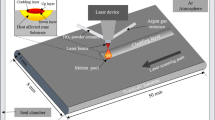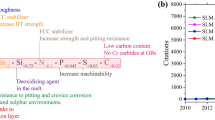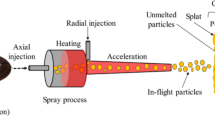Abstract
A systematic experimental investigation concerning the fretting-induced tribo-chemical state and its effect on the fretting wear behavior of titanium alloys under the vacuum atmospheres (4 × 10–3 Pa and 4 × 10–1 Pa) in different fretting regimes is reported. An in situ XPS analysis tester was developed to capture the real tribo-chemical state of worn surface for all test conditions. Results show that samples subjected to different vacuum atmospheres have varied tribo-chemical states depending on the fretting regime, which play significantly different roles in determining the associated damage mechanisms and the resulting fretting wear resistance. Under both vacuum atmospheres, in the partial slip regime (PSR) the worn scars were mainly covered by TiO2, showing comparable levels of very slight damage, while in the mixed fretting regime (MFR), the tribo-layer is still mainly consisted of TiO2, but with an evident peak of Ti metal for the high vacuum degree (4 × 10–3 Pa) in MFR, showing a mild damage. In contrast, in the gross slip regime (GSR), Ti metal was prone to be oxidized to Ti2O3 and TiO on the worn scar, especially for the low vacuum degree (4 × 10–1 Pa) having a highest content of Ti2O3. It might be inferred that the tribo-layer containing more Ti2O3 formed during fretting wear process is susceptible to be broken, hence showing a highest fretting wear volume in GSR for the low vacuum degree. The results suggest that for the vacuum environments, the Ti6Al4V may be more suitable to be used under the high vacuum atmosphere.















Similar content being viewed by others
Data Availability
The data used in this research are available upon request. Please contact the corresponding author for access to the data.
References
Lee, Y.H., Kim, H.K.: Fretting wear behavior of a nuclear fuel rod under a simulated primary coolant condition. Wear 301, 569–574 (2013). https://doi.org/10.1016/j.wear.2013.01.067
Liu, H.W., Xu, X.J., Zhu, M.H., Ren, P.D., Zhou, Z.R.: High temperature fretting wear behavior of WC–25Co coatings prepared by D-gun spraying on Ti–Al–Zr titanium alloy. Tribol. Int. 44, 1461–1470 (2011). https://doi.org/10.1016/j.triboint.2011.01.002
Shen, Y., Zhang, D., Ge, S.: Effect of fretting amplitudes on fretting wear behavior of steel wires in coal mines. Min. Sci. Technol. 20, 803–808 (2010). https://doi.org/10.1016/S1674-5264(09)60285-4
Yang, Y., Wang, C., Gesang, Y., Shang, H., Wang, R., Liang, Y., Wang, T., Chen, Q., Shao, T.: Fretting wear evolution of γ-TiAl alloy. Tribol. Int. 154, 106721 (2021). https://doi.org/10.1016/j.triboint.2020.106721
Dong, H., Bell, T.: Tribological behaviour of alumina sliding against Ti6Al4V in unlubricated contact. Wear 225–229, 874–884 (1999). https://doi.org/10.1016/S0043-1648(98)00407-4
Lebedeva, I.L., Presnyakova, G.N.: Adhesion wear mechanisms under dry friction of titanium alloys in vacuum. Wear 148, 203–210 (1991). https://doi.org/10.1016/0043-1648(91)90284-2
Diomidis, N., Mischler, S.: Third body effects on friction and wear during fretting of steel contacts. Tribol. Int. 44, 1452–1460 (2011). https://doi.org/10.1016/j.triboint.2011.02.013
Mary, C., Le Mogne, T., Beaugiraud, B., Vacher, B., Martin, J.M., Fouvry, S.: Tribochemistry of a Ti alloy under fretting in air: evidence of titanium nitride formation. Tribol. Lett. 34, 211–222 (2009). https://doi.org/10.1007/s11249-009-9426-6
Wit, Ed., Blanpain, B., Froyen, L., Celis, J.P.: The tribochemical behaviour of TiN-coatings during fretting wear. Wear 217, 215–224 (1998). https://doi.org/10.1016/S0043-1648(98)00183-5
Molinari, A., Straffelini, G., Tesi, B., Bacci, T.: Dry sliding wear mechanisms of the Ti6Al4V alloy. Wear 208, 105–112 (1997). https://doi.org/10.1016/S0043-1648(96)07454-6
Farokhzadeh, K., Edrisy, A.: Transition between mild and severe wear in titanium alloys. Tribol. Int. 94, 98–111 (2016). https://doi.org/10.1016/j.triboint.2015.08.020
Li, X.X., Zhou, Y., Li, Y.X., Ji, X.L., Wang, S.Q.: Dry sliding wear characteristics of Ti-6.5Al-3.5Mo-1.5Zr-0.3Si alloy at various sliding speeds. Metall. Mater. Trans. A 46, 4360–4368 (2015). https://doi.org/10.1007/s11661-015-3019-9
Wang, L., Zhang, Q.Y., Li, X.X., Cui, X.H., Wang, S.Q.: Severe-to-mild wear transition of titanium alloys as a function of temperature. Tribol. Lett. 53, 511–520 (2014). https://doi.org/10.1007/s11249-013-0289-5
Wang, L., Zhang, Q.Y., Li, X.X., Cui, X.H., Wang, S.Q.: Dry Sliding Wear Behavior of Ti-6.5Al-3.5Mo-1.5Zr-0.3Si Alloy. Metall. Mater. Trans. A 45, 2284–2296 (2014). https://doi.org/10.1007/s11661-013-2167-z
Hierro-Oliva, M., Gallardo-Moreno, A.M., González-Martín, M.L.: XPS analysis of Ti6Al4V oxidation under UHV conditions. Metall. Mater. Trans. A 45, 6285–6290 (2014). https://doi.org/10.1007/s11661-014-2570-0
Alam, M.O., Haseeb, A.S.M.A.: Response of Ti–6Al–4V and Ti–24Al–11Nb alloys to dry sliding wear against hardened steel. Tribol. Int. 35, 357–362 (2002). https://doi.org/10.1016/S0301-679X(02)00015-4
Mao, Y.S., Wang, L., Chen, K.M., Wang, S.Q., Cui, X.H.: Tribo-layer and its role in dry sliding wear of Ti–6Al–4V alloy. Wear 297, 1032–1039 (2013). https://doi.org/10.1016/j.wear.2012.11.063
Mercer, A.P., Hutchings, I.M.: The influence of atmospheric composition on the abrasive wear of titanium and Ti-6Al-4V. Wear 124, 165–176 (1988). https://doi.org/10.1016/0043-1648(88)90242-6
Liu, Y., Yang, D.Z., He, S.Y., Wu, W.L.: Microstructure developed in the surface layer of Ti-6Al-4V alloy after sliding wear in vacuum. Mater. Charact. 50, 275–279 (2003). https://doi.org/10.1016/s1044-5803(03)00125-6
Yang, L.Q., Zhong, H., Lv, G., Yue, Y., Guo, B.Y., Ma, M.Z., Liu, R.P.: Dry sliding behavior of a TiZr-based alloy under air and vacuum conditions. J. Mater. Eng. Perform. 28, 3402–3412 (2019). https://doi.org/10.1007/s11665-019-04100-4
Chelliah, N., Kailas, S.V.: Synergy between tribo-oxidation and strain rate response on governing the dry sliding wear behavior of titanium. Wear 266, 704–712 (2009). https://doi.org/10.1016/j.wear.2008.08.011
Zhong, H., Dai, L.Y., Yang, Y.J., Yue, Y., Wang, B.A., Zhang, X.Y., Ma, M.Z., Liu, R.P.: Vacuum tribological properties of Ti-20Zr-6.5Al-4V alloy as influenced by sliding velocities. Metall. Mater. Trans. A 48, 5678–5687 (2017). https://doi.org/10.1007/s11661-017-4301-9
Yazdanian, M.M., Edrisy, A., Alpas, A.T.: Vacuum sliding behaviour of thermally oxidized Ti–6Al–4V alloy. Surf. Coat. Technol. 202, 1182–1188 (2007). https://doi.org/10.1016/j.surfcoat.2007.05.069
Zhou, Y., Shen, M., Cai, Z., Peng, J., Zhu, M.: Study on dual rotary fretting wear behavior of Ti6Al4V titanium alloy. Wear 376–377, 670–679 (2017). https://doi.org/10.1016/j.wear.2016.10.027
Qiu, X., Wei, X., Xu, X., Xu, W., Zhu, M.: Dependence of fretting wear resistance on microstructural features of alloyed steels. Tribol. Int. 137, 39–45 (2019). https://doi.org/10.1016/j.triboint.2019.04.028
Wei, X., Sheng, L., Li, H., Xu, X., Peng, J., Gou, G., Zhu, M.: The effect of oxygen pressure on the fretting wear of titanium alloys. Int. J. Mod. Phys. B 34, 2050128 (2020). https://doi.org/10.1142/s0217979220501283
Cheng, X., Wei, X., Li, H., Wei, H., Xu, X., Sheng, L., Zhu, M.: Investigation on the fretting wear behavior of titanium alloy under different atmospheres by an in situ XPS spectrometry. Int. J. Mod. Phys. B 36, 2250109 (2022). https://doi.org/10.1142/s0217979222501090
Zhou, Z.R., Nakazawa, K., Zhu, M.H., Maruyama, N., Kapsa, P., Vincent, L.: Progress in fretting maps. Tribol. Int. 39, 1068–1073 (2006). https://doi.org/10.1016/j.triboint.2006.02.001
Zhu, M.H., Zhou, Z.R.: On the mechanisms of various fretting wear modes. Tribol. Int. 44, 1378–1388 (2011). https://doi.org/10.1016/j.triboint.2011.02.010
Fouvry, S., Kapsa, P., Vincent, L.: Analysis of sliding behaviour for fretting loadings: determination of transition criteria. Wear 185, 35–46 (1995). https://doi.org/10.1016/0043-1648(94)06582-9
Chaudhry, V., Kailas, S.V.: Damage mechanisms in stainless steel and chromium carbide coatings under controlled environment fretting conditions. Wear 334–335, 75–81 (2015). https://doi.org/10.1016/j.wear.2015.01.001
Vingsbo, O., Söderberg, S.: On fretting maps. Wear 126, 131–147 (1988). https://doi.org/10.1016/0043-1648(88)90134-2
Mindlin, R.D.: Compliance of elastic bodies in contact. J. Appl. Mech. 16, 529–268 (1949). https://doi.org/10.1115/1.4009973
Dearnley, P.A., Dahm, K.L., Çimenoǧlu, H.: The corrosion–wear behaviour of thermally oxidised CP-Ti and Ti–6Al–4V. Wear 256, 469–479 (2004). https://doi.org/10.1016/s0043-1648(03)00557-x
Mary, C., Fouvry, S., Martin, J.M., Bonnet, B.: High temperature fretting wear of a Ti alloy/CuNiIn contact. Surf. Coat. Technol. 203, 691–698 (2008). https://doi.org/10.1016/j.surfcoat.2008.08.043
Gu, Y., Zhao, X., Liu, Y., Lv, Y.: Preparation and tribological properties of dual-coated TiO2 nanoparticles as water-based lubricant additives. J. Nanomater. 2014, 1–8 (2014). https://doi.org/10.1155/2014/785680
Zhou, Z.R., Vincent, L.: Mixed fretting regime. Wear 181–183, 531–536 (1995). https://doi.org/10.1016/0043-1648(95)90168-X
Zhang, Y., Mollon, G., Descartes, S.: Significance of third body rheology in friction at a dry sliding interface observed by a multibody meshfree model: Influence of cohesion between particles. Tribol. Int. 145, 106188 (2020). https://doi.org/10.1016/j.triboint.2020.106188
Godet, M.: The third-body approach: a mechanical view of wear. Wear 100, 437–452 (1984). https://doi.org/10.1016/0043-1648(84)90025-5
Kirk, A.M., Sun, W., Bennett, C.J., Shipway, P.H.: Interaction of displacement amplitude and frequency effects in fretting wear of a high strength steel: Impact on debris bed formation and subsurface damage. Wear 482–483, 203981 (2021). https://doi.org/10.1016/j.wear.2021.203981
Zhu, T., Shipway, P.H., Sun, W.: The dependence of wear rate on wear scar size in fretting; the role of debris (third body) expulsion from the contact. Wear 440–441, 203081 (2019). https://doi.org/10.1016/j.wear.2019.203081
Ming, Q., Yongzhen, Z., Jun, Z., Jianheng, Y.: Correlation between the characteristics of the thermo-mechanical mixed layer and wear behaviour of Ti–6Al–4V alloy. Tribol. Lett. 22, 227–231 (2006). https://doi.org/10.1007/s11249-006-9088-6
Singh, K., Raman, S.G.S., Gnanamoorthy, R.: Effect of thermal oxidation duration on fretting wear behavior of Ti6Al4V in Ringer’s solution. Trans. Indian Inst. Met. 75, 1629–1639 (2022). https://doi.org/10.1007/s12666-022-02543-3
Wang, S., Liao, Z., Liu, Y., Liu, W.: Influence of thermal oxidation duration on the microstructure and fretting wear behavior of Ti6Al4V alloy. Mater. Chem. Phys. 159, 139–151 (2015). https://doi.org/10.1016/j.matchemphys.2015.03.063
Sheng, L., Deng, X., Li, H., Ren, Y., Gou, G., Xu, X., Wang, Z., Zhu, M.: Fretting wear behavior of thermal-oxidation on titanium alloy in air and vacuum atmosphere. Int. J. Mod. Phys. B 35, 2150135 (2021). https://doi.org/10.1142/s0217979221501356
Acknowledgements
The authors gratefully acknowledge financial support provided by Sichuan Science and Technology Program (2023NSFSC0413), the Natural Science Foundation of China (51575459) and the Fundamental Research Funds for the Central Universities (2682023GF018).
Funding
This work was supported by the Sichuan Science and Technology Program (2023NSFSC0413), the Natural Science Foundation of China (51575459) and the Fundamental Research Funds for the Central Universities (2682023GF018).
Author information
Authors and Affiliations
Contributions
Jianjun Long and Xuejiao Wei: experiments, data analysis and manuscript preparation. Xixi Cheng, Yiting Dong and Hao Li: materials characterization and data analysis. Xiaojun Xu and Minhao Zhu: supervision, funding acquisition and the revision and embellishment of the manuscript.
Corresponding author
Ethics declarations
Competing interests
The authors declare no competing interests.
Additional information
Publisher's Note
Springer Nature remains neutral with regard to jurisdictional claims in published maps and institutional affiliations.
Rights and permissions
Springer Nature or its licensor (e.g. a society or other partner) holds exclusive rights to this article under a publishing agreement with the author(s) or other rightsholder(s); author self-archiving of the accepted manuscript version of this article is solely governed by the terms of such publishing agreement and applicable law.
About this article
Cite this article
Long, J., Wei, X., Dong, Y. et al. In Situ XPS Analysis of Tribo-chemical Behavior in Titanium Alloy Exposed to Fretting Wear Under the Vacuum Environments. Tribol Lett 72, 43 (2024). https://doi.org/10.1007/s11249-024-01842-8
Received:
Accepted:
Published:
DOI: https://doi.org/10.1007/s11249-024-01842-8




